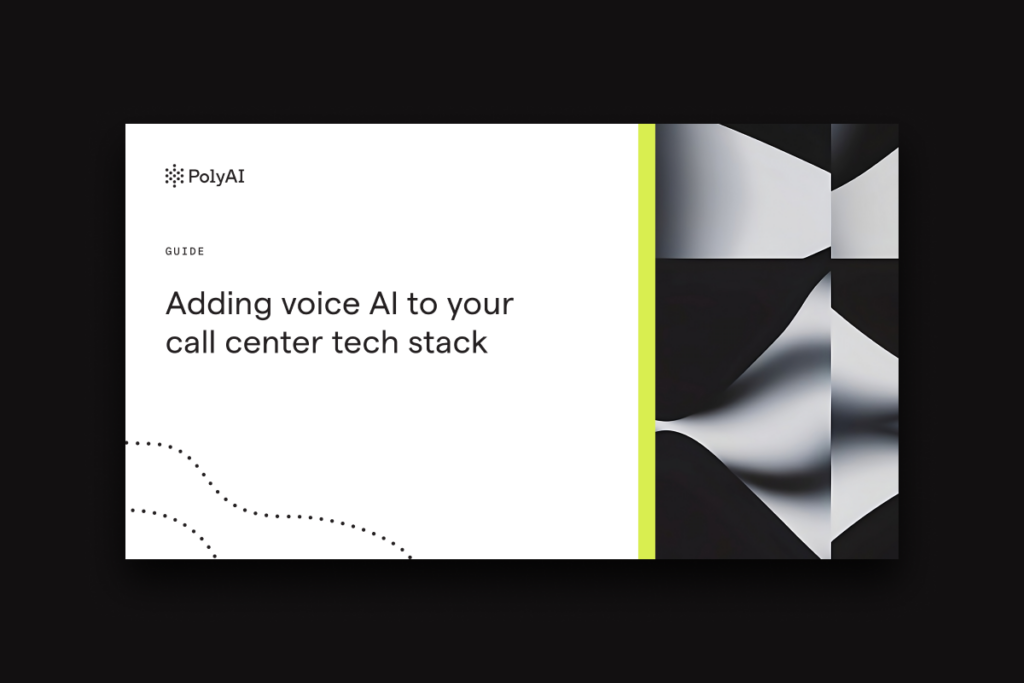Table of Contents
It’s no surprise that everything seems to be about AI these days. Yet even though it can feel like old news within the repetitive media landscape, this technology remains the dominant force across nearly every industry. As AI development moves at a clip, valid use cases continue building across the enterprise. But despite years of growth for this groundbreaking technology, contact centers have been one of the most significant and successful areas for AI adoption.
AI agents can manage up to 90% of repetitive tasks, empowering agents to focus on higher-quality, complex work. But incorporating AI isn’t just about cutting costs and replacing the inherently human aspects of customer service—it is actively reimagining digital transformation on the enterprise level. As the transition away from basic services becomes more of a need than a nice-to-have, rapid AI adaptation and experimentation prove critical in providing a holistic customer experience.
The genesis of this conversation started with our very own Nikola Mrkšić, CEO & Co-Founder of PolyAI, on a recent episode of the Tech Transformed podcast. Mrkšić, alongside Jon Arnold, Principal of J Arnold Associates, deep dives into all things AI, particularly agentic AI, and its potential to transform contact centers.
If you missed the episode, don’t fret—we’ve got you covered on every crucial insight.
From the importance of automation and experimentation to the emergence of customer command centers, the 5 benefits outlined below solidify agentic AI as one of the most potent tools to equip your agents with.
The top 5 benefits of agentic AI
1. Remedy understaffing and demand increases
Most enterprise contact centers today experience a massive volume of repetitive tasks at grand scale. These monotonous queries can range from making reservations to asking questions about medical insurance or mortgage payments and even granular standard failure demands, such as overcharges. And while every customer query is important and worthy of resolution, the tedious nature of nonstop, unvarying requests builds up over time. The primary benefit of voice AI is the immediate relief it provides during demand surges, seasonal upticks, and staffing inadequacies.
Agentic AI can help create a front office fortress, protecting agents’ time and energy on the backend. Where in the past, especially during upticks in demand, a customer might not hear back on a concern for a few days, automation can provide instant support. Agentic technology can look at a computer screen, click and move around, and read things at a much faster pace than human agents.
The healthcare industry is increasingly adopting AI to improve operational efficiency, dramatically changing how healthcare providers engage with patients–and its paying off. Find out how Howard Brown Health used PolyAI to offload 30% of calls to an AI agent, surpassing their initial target of 20%.
2. Improve agent quality amidst budgetary concerns
In the battle against agent burnout, attrition, lack of resourcing, and inefficient time allocation, it’s unsurprising, even intuitive, to think of cost-cutting as the main benefit to implementing AI solutions. While some might liken this to the classic chicken-egg riddle, Mrkšić believes that a cost-cut-first mentality doesn’t get to the heart of the problem, “I think many start from cost-cutting as the primary high-level explanation for what’s going on, but we’ve found that is not the case. It’s one of the corollaries, not necessarily where people start. They’re not doing customer service well enough.”
More often than not, strict budgeting twists a contact center’s arm into reducing the number of agents or simply not increasing salaries. Over time, this labor environment becomes increasingly difficult, especially post-Covid, where CX leaders find themselves understaffed to perform crucial job functions.
Add sluggish technological advancement within the broader contact center space to budgetary limitations, and it becomes even more apparent where AI shines. Agentic systems can learn and adapt to create workflows performed specifically by AI agents instead of humans, making up for lost labor supply due to budget cuts or wage dissatisfaction.
As the AI hivemind matures, systems like AI agents can handle the majority of tasks typically performed by tier-one customer service reps. This helps reduce attrition, as human agents grow into knowledge workers. With repetitive routine requests out of the way, they can supervise tier-one agents and apply critical thinking to complex customer situations, while AI manages the repetitive tasks.
Want to dig further into the observability of agentic AI? Our podcast episode, Deep Learning with PolyAI: What the #$%& is agentic AI anyway?, goes in on this technology’s hive structure and so much more.
3. Go from contact center to command center
Once AI has been operationally integrated, the contact center can begin to look and act like a true command center. In the command center, the bidirectional stream of information starts to flow in a seamless, holistic way. Think of agentic AI as AI that can do work on an agent’s behalf. The work being done is asynchronous, almost like a balm that smooths the rough points that connect various workflows.
Agentic AI can join existing workflow ecosystems and breeze through repetitive tasks for agents. Imagine a contact center free from inundating managers with prescribed answers to basic questions. Instead, their primary work can focus on solving complex issues as they arise.
88% of CX trendsetters consider personalization critical as they incorporate emerging technologies to meet rising customer expectations–read more on this finding and other voice AI trends in our Zendesk 2025 CX Trends Report highlights blog.
Agentic technology can also alleviate potential bottlenecks in other areas of the business. Mrkšić uses a utility company as an example, “Let’s say there is a utility company and the number of callers being charged too much in Palo Alto grows tenfold in a day. The business can do its best to tell people to submit a form online and say they’ll deal with it. But if you deal with the underlying issue, then maybe you don’t get 300 times as many people submitting that form and overwhelming a different part of your business.”
4. Drive relevant insights for the entire business
When a contact center can quickly and effectively pull structured conversational data from massive reservoirs of customer interactions, they can make smarter decisions for their agents and the business at large. For instance, if a manager can easily access organized data, they can report on the inner workings with better precision. If you can identify the why behind a problem, such as a struggle to meet demand, the contact center turns from a cost center into a revenue generator.
It is not uncommon for an organization to spend exorbitant amounts of money on marketing or third-party surveys. But if a contact center is driving insights from within the business, utilizing the thousands of AI-filtered customer interactions, the entire analytical stream comes alive. According to Mrkšić, a stronger analytical approach leads to, “providing better, more reliable service.”
Beyond CX, agentic AI can have a reverberating impact on the rest of the business. If the C-Suite sees the quantifiable success of AI deployment within their contact center function, it could drive adoption within other teams. Data can then start feeding into the contact center from marketing, sales, invoicing, or shipping, building a true 360 degree customer profile.
5. Create a fail fast culture with room to experiment
When demand is high, staffing and agent morale are often minimal, hindering a contact center from the privilege of experimentation. The focus fixates on manic volume control and keeping heads just barely above water. With agentic AI and the speed with which it operates, contact center integration reveals itself quickly, giving CX leaders a fairly solid idea of what is and is not working. The use of this technology is not about implementing small, barely noticeable changes—because, let’s face it, big problems require bold solutions.
The speed allows contact centers to experiment more frequently, in both the product selection phase and the post-implementation phase. Unlike other technologies, there is more room to try different partners and solutions in order to find the perfect fit. Depending on the demand, attrition rate, and work satisfaction level, shaving off a few seconds from a call will simply not cut it. Agentic AI creates opportunities for CX leaders to rethink what is possible and build a blueprint for what customer service can and should look like.
Learn how Paul Pugal, the Managing Director of Customer Experience for FedEx, UK, and Ireland, utilizes PolyAI to stay innovative and develop a culture of experimentation within a large organization.
Agentic AI: another dimension to conversational AI
Conversational AI has long been a part of contact center operations, especially those that seek consistent, cost-mindful automation. The basic deterministic logic of this technology has helped countless customer queries through fixed decision trees. But as customer expectations grow and challenges take on a multiplex nature, traditional deterministic AI starts to fall short of easing contact center demands.
Agentic AI has the adaptability to respond to more unpredictable situations and improve its learning capabilities over time. While it currently serves as a tool for automating tasks, its next growth spurt will come in the form of transformative approaches to solving problems, allocating resources, and influencing business outcomes. While agentic AI solutions get to work immediately and reveal the fruit of their labor (or lack thereof) expeditiously, scaling this technology is ultimately a marathon, not a sprint.
The real power of agentic AI is about knowing when and how to deploy it into your existing infrastructure. Speak to our team today about how PolyAI can help you implement the world’s most lifelike and adaptable AI agent to deliver effortless CX at scale.




